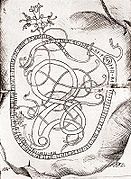Granby runestone
The Viking Age runestone from Granby ( Swedish Granbyhallen ), referred to as U 337 in the Rundata catalog , dates from the 9th century and covers about ten square meters of the surface of a smooth boulder . The inscription with its almost 200 runes is the second longest in Uppland in Sweden after U 29 . However, five to seven runes at the beginning of the text have been lost.
The rune plate ( Swedish runhalls ) of Granby in the parish of Orkesta in the municipality of Vallentuna has a runic inscription carved into a rock. The monument to a father, a mother and a few other people (Häming, Själve, Johan, Vargas, Kalfr Gärdar) mentions the property of the father Finnvid. Some family members are mentioned on other local rune stones: Kalfr on stones U 338 and U 341 in Söderby and on U 342 in Granby and the mother Ragnfríðr on U 338.
The inscription was carved by the rune master Visate, who worked in Uppland in the second half of the 11th century, where he signed seven other rune stones. In the runic text, Visäte wrote Guð ("God") with an o-rune instead of a u-rune, an alternative spelling that he also used on U 74 and on U Fv1972 for the name Guðlaug.
The inscription is classified as a Pr4 runestone style, which is also known as the Urnes style . Inscriptions in this style are characterized by slender, stylized animals woven into tight patterns. The animal heads can typically be recognized in profile with slender almond-shaped eyes and upward projections on the noses and necks.
- Granby runestone
The rune stone of Yttergärde is about 1 km to the northeast .
literature
- Klaus Düwel: Runic lore . 3. Edition. Verlag JB Metzler, Stuttgart, Weimar 2001.
- Lars Magnar Enoksen: Runor - Historia, Tydning, Tolkning . Historiska Media, Lund 1998.
Web links
- Runestone from Granby - entry in the database "Fornsök" des Riksantikvarieämbetet (Swedish)
Coordinates: 59 ° 35 '42.6 " N , 18 ° 5' 57.4" E




